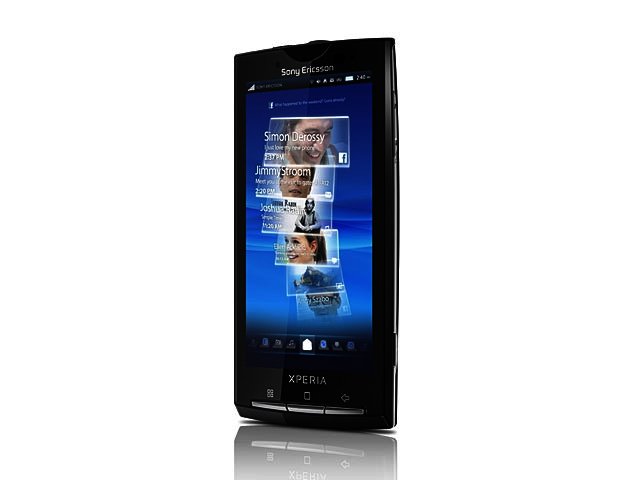Let’s get this straight- we’re big fans of Sony Ericsson (SE) here in the office, or rather we were. Their phones used to be well thought out tech, full of excellent extras that made for a very enjoyable user experience. But for almost two years we saw a steady decline, with even their usually smashing smartphones just not being able to compare with what HTC and Nokia had on offer.
But now with the release of the Xperia X10i it seems like things might have taken a turn for the better. Thanks to the Android OS and the speedy 1 GHz Qualcomm Snapdragon powering the X10i, Sony Ericsson seems to be back in the game.
All you need
The X10i includes all you expect from a smartphone- GPS, Wi-Fi, email integration, document viewing (but not editing unfortunately) and HSDPA. All this in a stylish, but big body with a superb 4” capacitive touch-screen. The screen might not be as big as the 4.3” monster on the HD2, but it contains more pixels per inch for a crisper display.
That said the X10i is only slightly smaller than the huge HD2 and actually a bit thicker (11 mm vs. 13 mm). But Sony Ericsson users who grew-up with the bulky P900 should have no trouble switching over. Battery life was above average, standing at about 1½ days with mild to heavy use.
Timescape
Just like HTC’s Sense UI, SE builds extra functionality into the phone, utilising their Timescape interface in much similar fashion. Timescape makes easy work of integrating Twitter and Facebook, with these, alongside new SMSs and emails, being displayed on the homescreen almost like cue cards.
Once you enter the Timescape application all messages are broken down into the separate categories alongside your call log, music and photos. Timescape works well at integrating all your messaging into one package, but we feel HTC’s Sense UI is still leading the pack. Seeing that Timescape is a first time effort we’re looking forward to where SE might take it in future.
Like other Android phones the X10i provides extra screens beside the home screen to populate with icons, with the slide-up main menu capturing all the pre-installed and further downloaded apps. With Android market getting more and more populated each day, you’ll find your main menu filling up rather quickly with cool downloads.
Browser
We had no problems browsing via the X10i’s on-board browser, apart from a lack of multi-touch pinch and zoom capabilities. Little things like not offering .com as a quick pick when typing in an URL seems to be evidence that SE aren’t back at their best yet. Typing via the onscreen QWERTY keyboard wasn’t a hassle at all and like previous Sony Ericssons, it saves words you use to provide it as a suggestion next time you type.
Calling problems
While typing SMSs or emails wasn't a hassle, we struggled calling with the X10i. Part of the problem is getting used to the fact that the X10i doesn’t carry physical buttons for “answer” and “end call”, or onscreen alternatives situated at the correct place, i.e. at the bottom left and right corner. It makes your initial dialling experience difficult, since you need to find the appropriate buttons on-screen, and trying to make a quick call while driving will almost certainly end up being your last one.
Almost as frustrating as this is the maximum volume of incoming calls. In the office it's fine but go outside you’ll find yourself struggling to hear what the other person is saying. Switching to speakerphone doesn’t help, since it’s also not up to standard.
Media
Although there is no mention of Sony’s Walkman or Cyber-shot brands anywhere, the X10i packs a whole lot of media punch. All your music, photos and video is arranged via Mediascape, which like Timescape does a good job of keeping everything in one place. While volume might be a problem when calling it certainly wasn’t the case playing music, with the sound loud and clear via earphones, with a 3.5 mm jack present.
The cameras on Android devices haven't been particularly impressive to date. The X10i steps up to the plate with a very decent 8.1 megapixel snapper behind it. Sony Ericsson is master at bringing a whole bunch of functionality to their cellphone cameras and the same holds true for the X10i. It packs scene recognition, touch capture and smile detection among other must haves like autofocus.
The cameras on Android devices haven't been particularly impressive to date. The X10i steps up to the plate with a very decent 8.1 megapixel snapper behind it. Sony Ericsson is master at bringing a whole bunch of functionality to their cellphone cameras and the same holds true for the X10i. It packs scene recognition, touch capture and smile detection among other must haves like autofocus.
Viewing the pictures on-board is a pleasure, and, although not mind-blowing, picture quality was good. The only criticism of the camera is a lack of a decent Xenon flash, with a single always-on LED light trying its best to keep up.
Conclusion
The X10i puts Sony Ericsson squarely back amongst the big guns of the smartphone market. It looks sleek, the Snapdragon processor is as always stunning and thank heavens they decided to drop Symbian. For a first attempt at the Android OS it’s an excellent effort and we can’t wait to see what SE will do with a bit of experience under their belt. They have to move quickly though, since guys like HTC are already lining up their new stars, with the release of the Desire in SA just two weeks away.
The Sony Ericsson X10i will make fans of the brand feel good, since it proves that SE isn’t out of the game completely and that maybe, just maybe, we will again see something marvellous from them in the near future.
PROS
Good social networking integration, speedy processor, good camera, nice interface.
CONS
Poor voice quality, no document editing.





